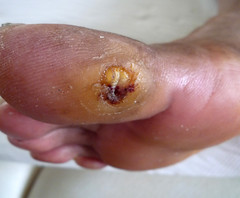| Ulcus bei Diabetes mellitus (Photo credit: rosmary) |
Diabetics Found to Underuse Special Footwear
Last Updated: 2013-01-24 13:35:26 -0400 (Reuters Health)
By Trevor Stokes
NEW YORK (Reuters Health) - Diabetic patients too often walk without wearing their custom-made shoes designed to prevent foot sores that can lead to infections and amputations, new research finds.
"It's very important that patients wear prescribed footwear as much as possible," said senior author, Sicco Bus, staff scientist with the Academic Medical Centre at the University of Amsterdam in the Netherlands. "High-risk patients are too low in their adherence, and that needs to be improved."
The research, published in Diabetes Care, monitored the walking habits of 107 diabetic patients during a two-week period and found that for nearly a third (29 percent) of the steps patients took, they didn't wear their custom-made shoes.
In the group of mostly white male retirees, patient adherence to the prescribed footwear ranged widely, from 10 to 100 percent.
The diabetic study participants were at high risk for preventable foot ulcers because of decreased feeling in their feet and previously-healed foot ulcers.
Even more alarming, researchers noted, patients failed to wear their ulcer-preventing shoes for 39 percent of the steps taken at home, where the majority of walking occurred.
Patients took an average of about 4,000 steps inside the home and 2,600 steps outside - where they walked in their protective shoes 87 percent of the time.
"Patients generally think they have to primarily wear their footwear when they go outside, even though the doctor tells them to wear (customized shoes) as much as possible," Bus told Reuters Health.
The researchers did not examine whether wearing prescription footwear less often led to increased foot ulcers, but unprotected diabetic feet are considered particularly vulnerable to injury because of decreased sensation, insufficient blood flow, dry cracked skin, foot deformities and slow wound healing.
Researchers assume custom-made footwear helps diabetic feet, a notion never tested with appropriate clinical trials, said Dr. Dereck Hunt, an associate professor of internal medicine at McMaster University in Canada who runs a diabetes clinic.
"We lack high-quality data, so that makes it more difficult for groups to focus on developing strategies to address adherence," Hunt told Reuters Health.
Each year, an estimated 600,000 diabetic patients get foot ulcers, resulting in 80,000 amputations, according to the American Diabetic Association.
And prior research suggests that less than a third of diabetic patients with existing foot problems wear their prescribed footwear 80 percent of the time or more, Bus and colleagues write.
During the current study, the researchers used shoe-implanted monitors that sample temperature to determine when patients were wearing their customized shoes and ankle monitors to record the number of steps taken.
Participants also kept diaries of times when they were inside or outside of the home. The patients were told the objective of the research was to study temperature and not shoe compliance.
Beyond custom-made protective footwear, experts said preventive treatments for foot ulcers typically include appropriate screening for foot deformities or sores, adequate follow up from podiatrists and proper foot care such as callous removal and nail care.
"With a little bit of common sense and technology, we can start to address this problem," said Dr. David Armstrong, professor of surgery and director of the Southern Arizona Limb Salvage Alliance at the University of Arizona.
Some technologies under exploration include shoe implants that ping to remind diabetic patients to wear their custom-made shoes and sensor mats that can detect weaknesses in the soles of feet.
Bus and his colleagues are also exploring whether making patients conscious of their non-compliance might help improve adherence.
Bus also suggests that diabetic patients keep a pair of pressure-relieving shoes or sandals specifically for indoor use.
"I can understand pretty well why patients take off their shoes when they are in the house because I do it myself, too," he said. "These shoes are quite heavy."
SOURCE: bit.ly/WbTnJN Diabetes Care, online January 15, 2013.
Copyright © 2013 Reuters Limited. All rights reserved. Republication or redistribution of Reuters content, including by framing or similar means, is expressly prohibited without the prior written consent of Reuters.








No comments:
Post a Comment